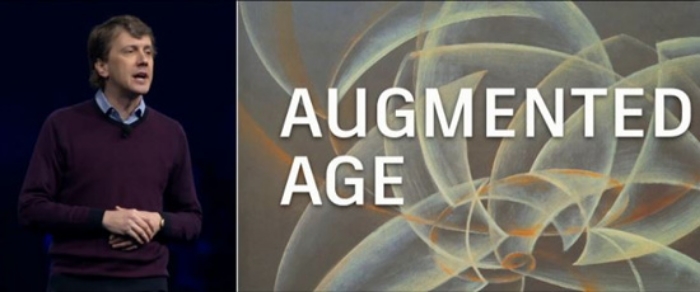
by JOHN GREGERSON | Dec 16, 2015
Las Vegas has long been known for distorting reality (and erasing memory), but soon it may also be cited as the birthplace of a new era. So claimed Autodesk CTO Jeff Kowalski earlier this month during a fascinating, 30-minute keynote before 10,000 attendees at Autodesk University.
“Welcome to the Augmented Age,” he announced to a packed auditorium and tens of thousands more watching online. “First came the Hunter-Gatherer Age, which lasted a couple of thousand years, followed by the Industrial Age, which lasted a couple of centuries, and then the Information Age, which has lasted just a few decades,” said Kowalski. But “over the next 20 years, we’re going to experience as much change in how we do our work as we have in the last 2,000 years,” he predicted.
“Over the next 20 years, we’re going to see as much change in how we work as we have in the last 2,000… Our technologies aren’t going to replace us. They are going to help us do things we never could before.”
As a result of augmenting human capabilities with computational systems that assist in thinking, and robotic systems that assist in making, Kowalski said that the workforce and the nature of physical work, itself, will be totally upended by 2035. In a presentation entitled “Augmented Age or The Future of Making Things,” he recounted initiatives that Autodesk has undertaken to supplement human thought with software systems that provide generative, intuitive and empathic information or feedback for various chores.
On such example is Bishop, a robotic arm that can assist in performing precise, repetitive tasks in construction, including creating apertures in drywall to accommodate outlets and switches. Earlier this year, our industry already saw robots named Hadrian and SAM that can lay hundreds of bricks in an hour, working at roughly three times the speed of human bricklayers.
In years to come, “we’re going to be augmented cognitively, physically and perceptually,” Kowalski concluded. “Our technologies aren’t going to replace us. They’re going to help us do things we never could before.”
Note: This article is from the BuiltWorlds archives. Some links, text, and images may not appear or function as originally formatted.



Discussion
Be the first to leave a comment.
You must be a member of the BuiltWorlds community to join the discussion.